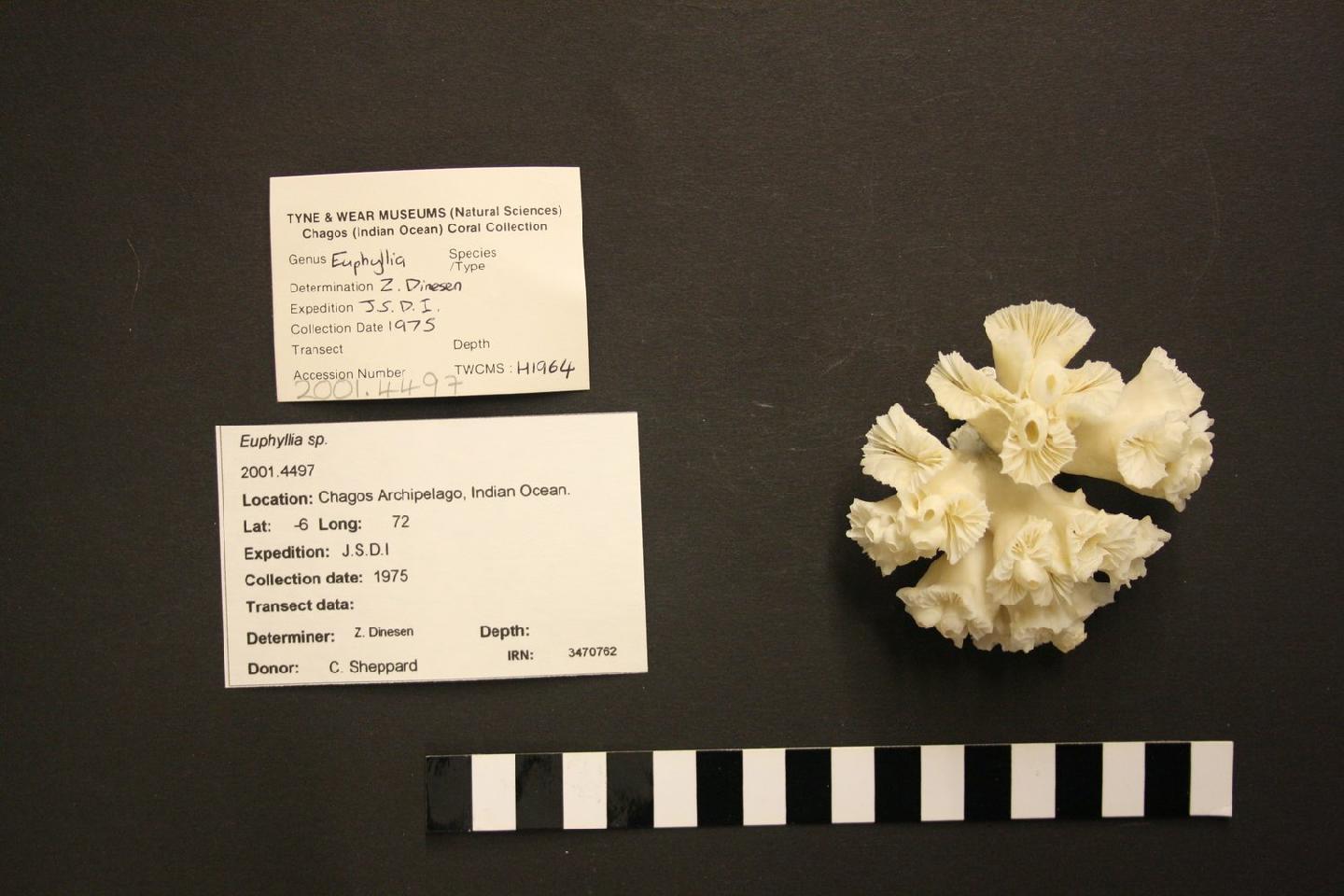
| About | | Search taxa | | Taxon tree | | Search literature | | Checklist | | Stats | | Log in |
WoRMS taxon detailsEuphyllia Dana, 1846
206703 (urn:lsid:marinespecies.org:taxname:206703)
accepted
Genus
Euphyllia (Euphyllia) Dana, 1846 · unaccepted > junior objective synonym
Fimbriaphyllia (Euphyllia) Dana, 1846 · unaccepted > superseded combination
Leptosmilia Milne Edwards & Haime, 1848 · unaccepted > junior subjective synonym
Plocophyllia Reuss, 1868 † · unaccepted > junior subjective synonym
marine,
Dana, J.D. (1846-1849). Zoophytes. United States Exploring Expedition during the years 1838-1842. <em>Lea and Blanchard, Philadelphia.</em> 7: 1-740, 61 pls. (1846: 1-120, 709-720; 1848: 121-708, 721-740; 1849: atlas pls. 1-61)., available online at https://www.biodiversitylibrary.org/page/18989497, http://www.sil.si.edu/digitalcollections/usexex/navigation/ScientificText/USExEx19_08select.cfm [details]
Description Colonies are flabelloid, phaceloid or meandro-phaceloid, the latter usually dome-shaped. Walls are thin and imperforate....
Description Colonies are flabelloid, phaceloid or meandro-phaceloid, the latter usually dome-shaped. Walls are thin and imperforate. Columellae are mostly absent. Septa are prominent, smooth-edged and imperforate. Polyps are extended day and night, are large and fleshy and have tentacles which very in shape for each species. Two species, E. divisa and E. ancora, can be distinguished only by their tentacles (Veron, 1986 <57>). [details]
Hoeksema, B. W.; Cairns, S. (2025). World List of Scleractinia. Euphyllia Dana, 1846. Accessed through: World Register of Marine Species at: https://www.marinespecies.org/aphia.php?p=taxdetails&id=206703 on 2025-07-17
Date action by 2006-09-12 06:54:36Z changed Martinez, Olga
Nomenclatureoriginal description
Dana, J.D. (1846-1849). Zoophytes. United States Exploring Expedition during the years 1838-1842. <em>Lea and Blanchard, Philadelphia.</em> 7: 1-740, 61 pls. (1846: 1-120, 709-720; 1848: 121-708, 721-740; 1849: atlas pls. 1-61)., available online at https://www.biodiversitylibrary.org/page/18989497, http://www.sil.si.edu/digitalcollections/usexex/navigation/ScientificText/USExEx19_08select.cfm [details] original description (of Leptosmilia Milne Edwards & Haime, 1848) Milne Edwards, H.; Haime, J. (1848). Observations sur les Polypiers de la famille des Astréides. <em>Comptes Rendus de l'Académie Des Sciences, Paris.</em> 27: 465–470. [details] original description (of Plocophyllia Reuss, 1868 †) Reuss AE. (1868). Paläontologische Studien über die älteren Tertiärschichten der Alpen. I. Die fossilen Anthozoen der Schichte von Castelgomberto. <em>Denkschriften der Kaiserlichen Akademie der Wissenschaften, Wien.</em> 28: 129-184, pls. 1-16., available online at https://biodiversitylibrary.org/page/7214847 [details] basis of record Veron JEN. (1986). Corals of Australia and the Indo-Pacific. <em>Angus & Robertson Publishers.</em> [details] Otheradditional source
Veron JEN, Pichon M. (1980). Scleractinia of Eastern Australia – Part III. Family Agariciidae, Siderastreidae, Fungiidae, Oculinidae, Merulinidae, Mussidae, Pectinidae, Caryophyllidae, Dendrophylliidae. <em>Australian Institute of Marine Science Monograph Series.</em> 4: 1-459. [details]
additional source Veron JEN. (2000). Corals of the World. Vol. 1–3. <em>Australian Institute of Marine Science and CRR, Queensland, Australia.</em> [details] additional source Matthai G. (1928). A Monograph of the Recent meandroid Astraeidae. <em>Catalogue of the Madreporarian Corals in the British Museum (Natural History).</em> 7: 1-288, pls. 1-72. [details] Available for editors additional source Yabe H, Sugiyama T. (1935). Revised list of the reef-corals from the Japanese seas and of the fossil reef corals of the raised reefs and the Ryukyu limestone of Japan. <em>Journal of the Geological Society of Japan.</em> 42: 379-403. page(s): 390 [details] additional source Neave, Sheffield Airey. (1939-1996). Nomenclator Zoologicus vol. 1-10 Online. <em>[Online Nomenclator Zoologicus at Checklistbank. Ubio link has gone].</em> , available online at https://www.checklistbank.org/dataset/126539/about [details] additional source Duncan PM (1884) A revision of the families and genera of the sclerodermic Zoantharia, Ed. & H., or Madreporaria (M. Rugosa excepted). Journal of the Linnean Society of London, 18: 1-204. [details] additional source Luzon KS, Lin MF, Ablan Lagman MCA, Licuanan WRY, Chen CA. (2017). Resurrecting a subgenus to genus: molecular phylogeny of Euphyllia and Fimbriaphyllia (order Scleractinia; family Euphyllidae; clade V). <em>PeerJ.</em> 5: e4074., available online at https://doi.org/10.7717/peerj.4074 [details] Available for editors additional source Luzon KS, Lin MF, Ablan Lagman MCA, Licuanan WRY, Chen CA. (2018). Correction: Resurrecting a subgenus to genus: molecular phylogeny of Euphyllia and Fimbriaphyllia (order Scleractinia; family Euphylliidae; clade V). <em>PeerJ.</em> 6: e4074/correction-1. [details] additional source Verrill, A. E. (1868-1870). Review of the corals and polyps of the west coast of America. <em>Transactions of the Connecticut Academy of Arts and Sciences.</em> 1, 6, 377-558. page(s): 513 [details] additional source Häussermann, V.; Försterra, G. (2003). First evidence for coloniality in sea anemones. Marine Ecology Progress Series, 257, 291-294 page(s): 291-292 [details] additional source Duerden, J. E. (1898). On the relations of certain Stichodactylinae to the Madreporaria. Journal of the Linnean Society of London (Zoology), 26, 635-653 page(s): 649 [details] additional source International Commission on Zoological Nomenclature. (2011). Coral taxon names published in 'Corals of the world' by J.E.N. Veron (2000): potential availability confirmed under Art. 86.1.2. <em>Bulletin of Zoological Nomenclature.</em> 68(3): 162-166. page(s): 166 [details] additional source Tkachenko, K. S.; Wu, B. J.; Fang, L. S.; Fan, T. Y. (2007). Dynamics of a coral reef community after mass mortality of branching Acropora corals and an outbreak of anemones. Marine Biology, 151, 185-194 page(s): 187 [details] additional source Arrigoni, R., Stolarski, J., Terraneo, T.I., Hoeksema, B.W., Berumen, M.L., Payri, C., Montano, S., Benzoni, F. (2023). Phylogenetics and taxonomy of the scleractinian coral family Euphylliidae. <em>Contributions to Zoology.</em> 92 (2): 130-171., available online at https://doi.org/10.1163/18759866-bja10041 [details]  Present Present  Inaccurate Inaccurate  Introduced: alien Introduced: alien  Containing type locality Containing type locality
Unreviewed
Description Colonies are flabelloid, phaceloid or meandro-phaceloid, the latter usually dome-shaped. Walls are thin and imperforate. Columellae are mostly absent. Septa are prominent, smooth-edged and imperforate. Polyps are extended day and night, are large and fleshy and have tentacles which very in shape for each species. Two species, E. divisa and E. ancora, can be distinguished only by their tentacles (Veron, 1986 <57>). [details]Remark Type species: Caryophyllia glabrescens Chamisso & Eysenhardt, 1821 (Veron, 1986). [details]
|

